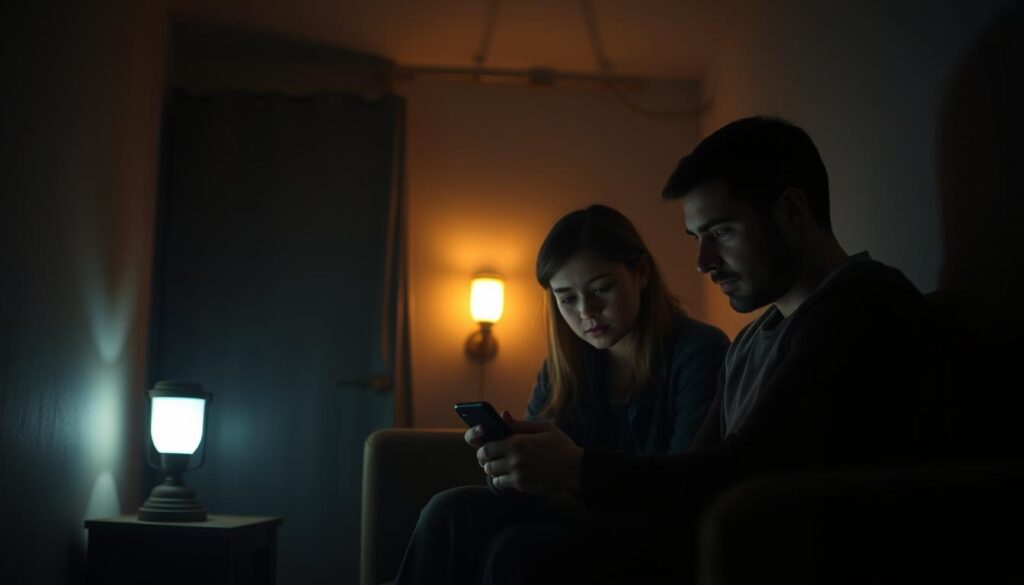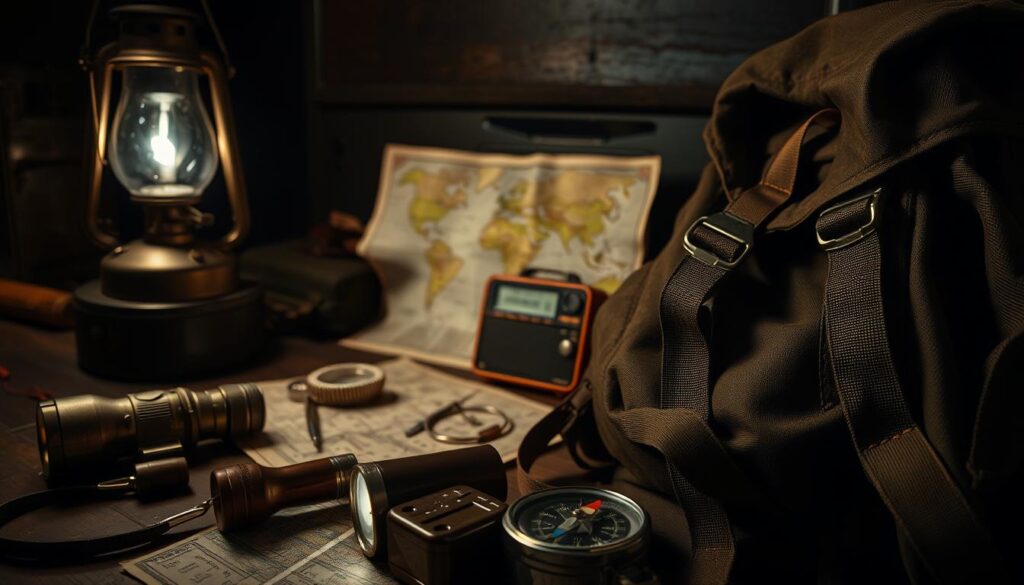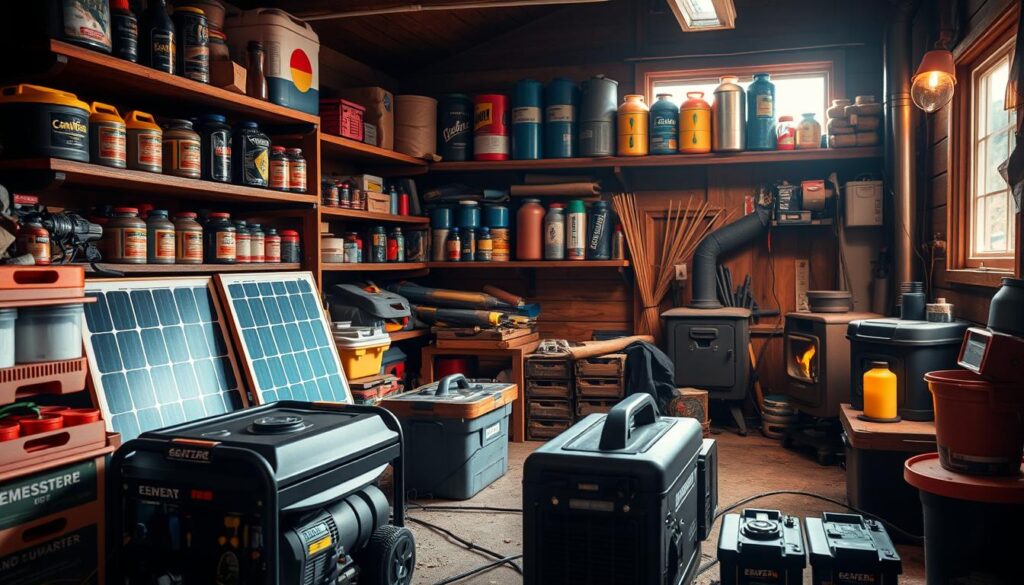Dealing with a power outage can be tough, but being ready helps a lot. The U.S. Energy Information Administration says we face about six hours of power cuts each year.
In this guide, I’ll share my tips on handling a power failure safely and comfortably. Knowing why they happen and getting your home ready are key steps.
I’ll give you useful tips and strategies to get through until the power comes back.
Key Takeaways
- Understand the causes of power outages
- Prepare your home for possible outages
- Learn about alternative power sources
- Stay safe during a power failure
- Use the right strategies to reduce disruptions
Understanding Why Power Outages Occur
I’ve had my share of power outages. Learning why they happen helps us deal with them better. Power outages, or blackouts and electricity failure, have many causes.
Common Causes of Power Outages
Severe weather is the main reason for power outages. Storms, hurricanes, and tornadoes can damage power lines and infrastructure. This leads to grid failure.
Equipment failures are another big reason. As our power grid gets older, the chance of equipment failure goes up. This can cause a blackout.
Human mistakes also cause power outages. Accidents during maintenance or construction can disrupt electricity. Plus, natural factors like birds nesting in equipment or squirrels chewing wires can cause outages.
“The increasing frequency of extreme weather events due to climate change is putting a strain on our power infrastructure, making it more susceptible to failures.”
Seasonal Factors Influencing Outages
Seasonal factors greatly affect power outage chances. Winter storms can weigh down power lines with snow and ice, causing them to break. Summer heatwaves increase electricity demand, straining the grid and possibly leading to electricity failure.
| Season | Common Causes | Impact on Grid |
|---|---|---|
| Winter | Heavy snow, ice storms | Power line breaks, equipment damage |
| Summer | Heatwaves, thunderstorms | Increased electricity demand, grid overload risk |
The Role of Infrastructure in Power Reliability
The age and condition of our power infrastructure are key to power reliability. Older infrastructure is more likely to fail. Without regular maintenance and upgrades, the risk of grid failure grows.
Investing in infrastructure and using modern technologies can improve power reliability. This includes upgrading old power lines, using smart grid technologies, and keeping equipment in good shape.
Preparing for a Power Outage
Preparing for a power outage is essential. It keeps me safe and reduces daily life disruptions. A good plan and the right supplies are key to handling an energy disruption smoothly.
Creating an Emergency Kit
First, I make an emergency kit for a power loss. It has water, non-perishable food, flashlights, and a battery-powered radio. These items help me stay informed and comfortable during an outage. For more tips, check out https://www.ready.gov/power-outages.
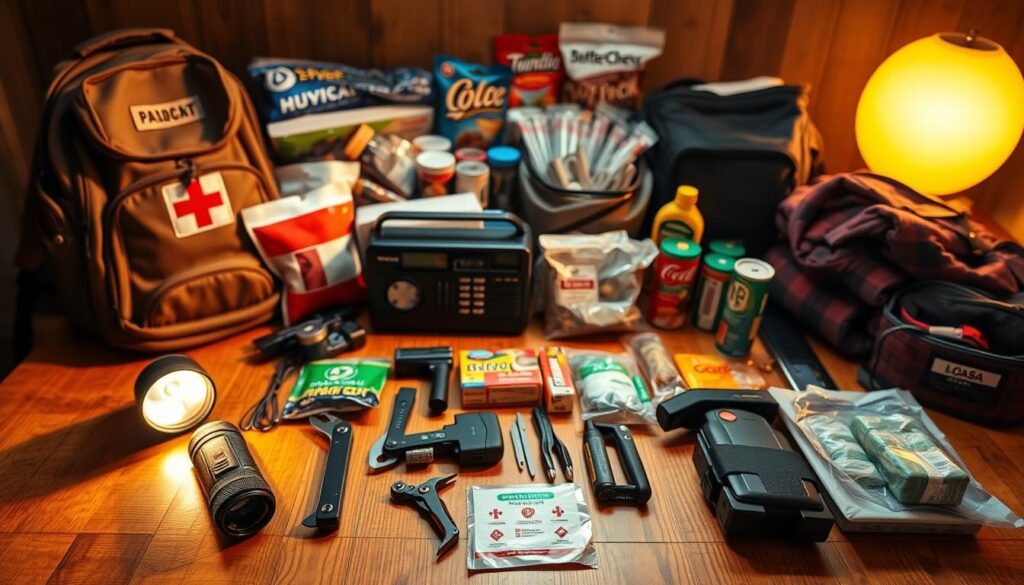
Stocking Up on Essentials
Stocking up on essentials is also important. I make sure to have enough water (at least one gallon per person per day) and non-perishable food. A manual can opener is also useful, as electric ones won’t work without power. This way, my home stays safe and comfortable until the power comes back.
Developing a Family Communication Plan
Creating a family communication plan is vital. It includes a meeting spot outside the home, a contact person, and a way to stay in touch without power. This plan helps my family stay together and informed during emergencies.
What to Expect During a Power Outage
Knowing what to expect during a power outage is key to staying safe and comfortable. My experiences show that outages can last from minutes to days, depending on the cause and how quickly the utility company responds.
Length of Outages: What I've Experienced
The time a power outage lasts can vary a lot. A power cut from a small problem might be fixed in hours. But, a big outage from a natural disaster could last for days.
| Cause of Outage | Typical Duration | Impact Level |
|---|---|---|
| Minor Technical Issue | Less than 2 hours | Low |
| Severe Weather | Several hours to days | High |
| Grid Overload | Several hours | Medium |
Effects on Daily Life and Routine
A power outage can really mess up your day. It can affect work, communication, food, and even your safety. For example, without power, your fridge might not work, causing food to spoil. For tips on managing during an outage, check out the Red Cross website.
Importance of Staying Informed
It’s very important to stay informed during an electrical outage. Use a battery-powered radio or a NOAA Weather Radio to get updates. This helps you make safe choices for yourself and your family.
By knowing what to expect and staying informed, you can reduce the impact of an outage and stay safe until the power comes back on.
Keeping Safe During a Power Outage
Understanding risks and taking precautions is key during a blackout. It’s vital to stay safe to avoid accidents and injuries.
Navigating Without Electricity
First, use alternative light sources. Flashlights are safer than candles. They provide light without the danger of fire.
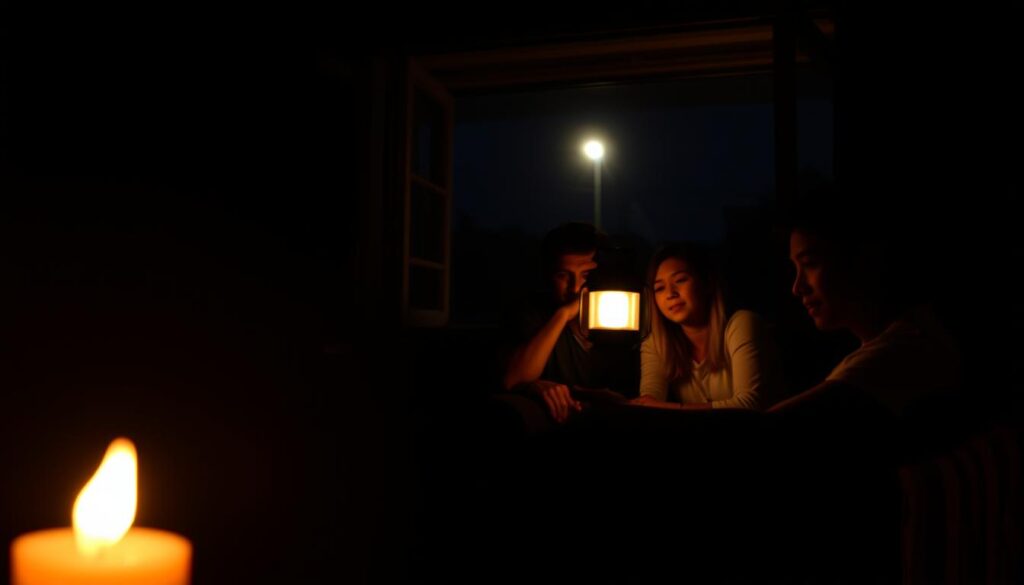
Fire Safety Tips with Candles
If candles are needed, place them on stable holders. Keep them away from things that can catch fire. Never leave a burning candle alone. Having a fire extinguisher or a bowl of water nearby is wise.
- Keep candles away from curtains and bedding.
- Use candle holders that won’t tip over.
- Never leave burning candles unattended.
Managing Food Safety in the Fridge
Keeping food safe during a power outage is critical. Close the fridge and freezer doors as much as you can. This helps food stay safe longer.
“Keeping your refrigerator and freezer doors closed is key to maintaining the cold temperature inside,” says a food safety expert. “This simple action can help prevent food spoilage and keep your family safe.”
Check the fridge and freezer temperatures often. Discard perishable foods if they’ve been above 40°F (4°C) for more than 2 hours.
Alternative Power Sources: My Recommendations
Having reliable alternative power sources is key during power failures. They keep essential devices running, ensuring safety and comfort.
There are many options for alternative power during an outage. These include battery-powered devices, generators, and solar-powered options. Each has its own benefits and things to consider.
Battery-Powered Devices
Battery-powered devices are a safe and easy choice for alternative power. They are simple to use and set up. I find that having battery-powered flashlights, radios, and chargers is very useful.
- Reliability: Battery-powered devices work well as long as you have spare batteries.
- Safety: They are safe to use indoors, avoiding the risk of carbon monoxide poisoning.
- Portability: Most battery-powered devices are easy to carry, making them portable.
Generators: What You Need to Know
Generators offer a lot of power during long outages. But, they need careful handling to stay safe.
| Type of Generator | Power Output | Safety Features |
|---|---|---|
| Portable Generators | Up to 10,000 watts | Automatic shut-off, ground fault protection |
| Standby Generators | 7,000 to 20,000 watts | Automatic transfer switch, weatherproof enclosure |
Solar-Powered Options
Solar-powered options are getting more popular as an alternative power source. They provide clean, renewable energy, which is great during the day.
When looking at solar-powered options, it’s important to get a reliable solar panel system and battery storage. This ensures power even at night or on cloudy days.
Understanding the different alternative power sources helps you prepare for power outages. Whether you choose battery-powered devices, generators, or solar-powered options, each has its own benefits. They all help make your experience safer and more comfortable during energy disruptions.
Strategies for Staying Comfortable
Staying comfortable without power is all about creativity. It can be tough to keep your home cozy when the lights go out. But, there are ways to make it work.
Staying Warm or Cool Without Power
Keeping the right temperature is key during a power outage. In the cold, blankets and sleeping bags are your best friends. For heat, use safe and approved portable heaters to stay safe.
In the heat, drink lots of water and use cool compresses. If you can, go to a cooler place.
| Temperature Challenge | Solution |
|---|---|
| Cold Weather | Use blankets, sleeping bags, and approved portable heaters |
| Hot Weather | Stay hydrated, use cool compresses, visit cooler public spaces |
Light Sources Beyond Electric Lamps
Having light when the power is out is essential. Candles and flashlights are classic choices. But, solar-powered lights are a safer, greener option.
When using candles, always follow fire safety tips to avoid accidents.
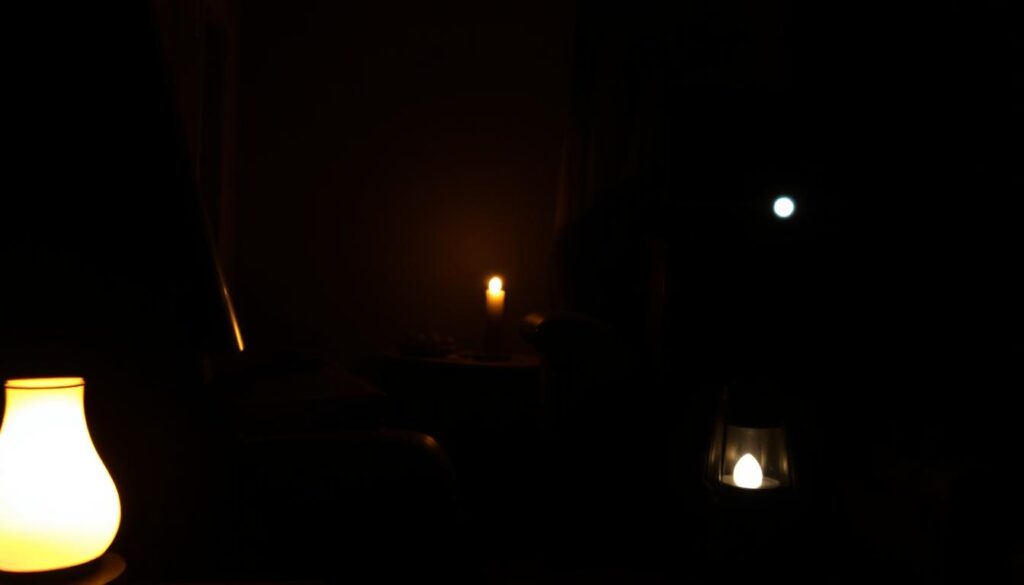
Entertaining Yourself When the Power's Out
Having fun during a power outage is possible. Try board games, card games, or reading to enjoy the time. For families, a collection of games and books is perfect for bonding.
- Board games
- Card games
- Books
- Storytelling
By using these tips, you can turn a power outage into a chance to relax and have fun with simple activities.
Managing Technology During Outages
Being ready for a power outage means more than just backup power. It’s also about smart tech management. When the lights go out, staying connected and having fun can be tough. But with the right plan, you can keep things running smoothly.
Charging Devices in Advance
Charging your devices before the power goes out is key. This includes your phone, laptop, and more. Charging them fully beforehand can give you hours of extra use, based on their battery life.
Using Power Banks Effectively
Power banks are vital for keeping your devices alive during an outage. A good power bank can charge your phone or other devices many times. Make sure to pick one that fits your needs.
| Device | Battery Capacity | Charging Times with Power Bank |
|---|---|---|
| Smartphone | 3000mAh | 2-3 times |
| Laptop | 5000mAh | 1-2 times |
| Tablet | 4000mAh | 1-2 times |
Utilizing Offline Entertainment
Charging devices and using power banks are important. But having fun without electricity is just as vital. Books, puzzles, and board games are great for keeping you entertained. They offer a nice break from the outage.
By charging devices early, using power banks wisely, and enjoying offline games, you can handle outages better. This makes the experience less stressful.
Communication During Power Outages
When the power goes out, it’s key to stay in touch with loved ones. I’ve learned how important it is to keep in contact during these times.
Keeping Your Phone Charged
It’s vital to keep your phone charged during an outage. I charge my devices early and have backup power like power banks. This way, I can stay connected.
Having a car charger is also smart. It’s a big help if you’re not at home when the power fails. Having many ways to charge can really ease stress.
Alternative Communication Methods
Using more than just your phone is smart. Two-way radios or satellite phones are great, mainly if you live in an area with frequent outages.
I’m thinking about getting a satellite phone for my family. We live in a place where bad weather is common. Two-way radios are good for talking to people nearby.
Staying Updated with Local News
Keeping up with local news is key during an outage. A battery-powered radio is very helpful for this.
I have a battery-powered radio in our emergency kit. It helps us stay informed when there’s no power. A NOAA Weather Radio is also good for weather updates.
| Communication Method | Advantages | Disadvantages |
|---|---|---|
| Cell Phone | Easily accessible, widely used | Dependent on cell towers, battery life |
| Two-way Radio | Reliable for short-range communication, no cell tower dependency | Limited range, requires compatible devices |
| Satellite Phone | Functional even without cell towers, reliable for emergency situations | Expensive, requires subscription or purchase |
| Battery-Powered Radio | Provides updates on local news and weather, doesn’t rely on cell towers | Dependent on battery life, limited to receiving information |
Using a mix of these methods helps you stay connected and informed during a power outage. Being ready and having the right tools is key.
Dealing with the Aftermath of a Power Outage
After a power outage, it’s important to focus on safety and comfort. Once the power is back on, check how it affected your home and daily life.
Checking for Damage in My Home
First, I look for any damage from the power failure. I check appliances and look for electrical damage. I also make sure all systems are working right.
Key areas to inspect include:
- Appliances and electronics for damage or malfunction
- Electrical panels and circuit breakers for signs of wear or damage
- Plumbing systems for any issues from the outage
Replacing Spoiled Food
Food safety is a big worry after a power outage. Throw away perishable items that were over 40°F for more than two hours to avoid illness.
Here’s a simple rule for fridge and freezer contents:
| Food Type | Condition After Outage | Action |
|---|---|---|
| Perishable (meat, dairy, etc.) | Above 40°F for more than 2 hours | Discard |
| Frozen Foods | Stil frozen or partially thawed | Check condition, use if safe |
| Canned Goods | No visible damage or spoilage | Safe to consume |
When to Contact Your Utility Company
If you lose power, know when to call your utility company. Report the outage right away. Follow up if it takes too long to fix.
By following these steps, you can handle a power outage well and recover smoothly.
Learning from My Power Outage Experiences
Thinking back on my power outage experiences has really helped me get ready for future blackouts. I’ve found out that having a good emergency kit and a family plan is key. It makes a big difference in staying safe and comfy.
Key Takeaways from My Experience
During a recent power outage, I learned how important being prepared is. I used my charged devices and other light sources to stay informed. This taught me the value of being ready for a power outage.
Preparing for the Next Power Outage
To get even better prepared, I’m going to buy a portable generator and more power banks. I also want to share what I’ve learned with friends and family. This way, they can be ready for a blackout too.
Sharing My Insights
I want to share my experiences and tips with others. I hope it helps them get ready for power outages. Whether it’s making an emergency kit or having backup power, being ready is key to staying safe.
FAQ
What are the common causes of power outages?
Power outages can happen due to severe weather, equipment failures, or human mistakes. Winter storms and summer heatwaves also play a role in power reliability.
How can I prepare for a power outage?
To prepare, make an emergency kit with important items. Stock up on non-perishable food and water. Also, have a plan for your family to stay in touch.
What should I do during a power outage to stay safe?
Use flashlights instead of candles to avoid fires. Keep your fridge and freezer safe to prevent foodborne illnesses. Stay updated with a battery-powered radio.
What are some alternative power sources I can use during a power outage?
You can use battery-powered devices, generators, or solar options. Just make sure to use them safely and follow the instructions.
How can I stay comfortable during a power outage?
Use alternative light sources to stay warm or cool. Games and books can also make the time more enjoyable.
How can I manage technology during a power outage?
Charge your devices before the outage. Use power banks and offline games for entertainment.
How can I stay connected with family and friends during a power outage?
Keep your phone charged. Use other ways to communicate and stay updated with local news.
What should I do after a power outage?
Check your home for damage. Replace any spoiled food. Contact your utility company if needed.
How can I learn from my power outage experiences?
Think about what worked and what didn’t. Share your experiences with others. Use these lessons to prepare better next time.
What is a grid failure?
A grid failure is when the electrical grid fails, causing a widespread power outage.
How can I prevent electrical outage?
You can’t prevent all outages, but being prepared helps. Having a plan can reduce the impact.
What is a blackout?
A blackout is when there’s a complete loss of power. It’s often due to severe weather or equipment failures.
What is a power cut?
A power cut is a temporary loss of power. It’s usually for maintenance or repairs.
How can I stay informed during a power loss?
Use a battery-powered radio or other means to stay informed. This helps you make better decisions.
What is an energy disruption?
An energy disruption is a power outage that affects energy supply. It’s often caused by severe weather or equipment failures.

